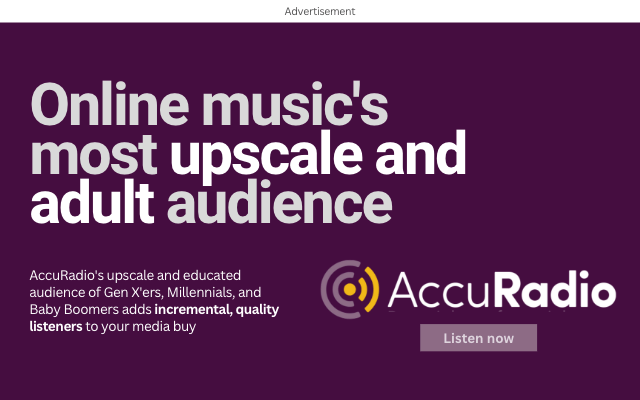 Steve Goldstein’s Amplifi Media works with media companies and podcasters in developing audio content strategies. This column was originally published on Blogstein, the Amplifi blog.
Steve Goldstein’s Amplifi Media works with media companies and podcasters in developing audio content strategies. This column was originally published on Blogstein, the Amplifi blog.
Originally published August 19.
Recently, I attended Don Anthony’s Morning Show Boot Camp for the first time in years. It was good to be back in a room filled with smart, funny morning show talent committed to connecting with listeners. Nearly 400 people attended—many paying their own way—to stay on top of trends and ideas. That says a lot about their dedication.
I’ve spent my career at the intersection of broadcasting and innovation. I was a co-founder of Saga Communications, helping grow it into one of the country’s leading radio groups, and ten years ago launched Amplifi Media, where we work with companies to develop on-demand content strategies that meet today’s audiences where they are.
The reality is that radio is still largely behind in the shift from linear to on-demand. That’s the challenge in front of us—and the opportunity.
I presented some data and moderated a panel called The Local Audio/Video Podcast Opportunity with Eva Ruth Moravec, Executive Producer of City Cast Austin, along with top radio talents Kevin Rolston and Bert Weiss. The session was well-received and I wanted to share some of the key insights with the wider radio industry.
Every morning, your show goes live to an audience that loves you. But here’s the hard truth:
They’re missing 83% of it.
We’ve run the numbers – real numbers, not vanity metrics. For seven top shows in a major market, 59% of the cume tuned in once per week. An additional 18% tuned in two times per week. Add it up, and the average listener never hears most of your best moments.
That’s a lot of missed laughs, stories left unfinished, and surprises that vanish into thin air. Once they’re gone, they’re gone, unless you make sure your content is available somewhere your audience can find it.
Podcasting isn’t a “nice to have.” It’s the most effective way to recapture the listening you’re already losing and to keep your audience engaged when they’re not in the car or near a radio. This isn’t about adding an extra platform. It’s about retention.
Your Market Is Wide Open
National podcasting is crowded, but local is underserved. And make no mistake, new players are already entering your market to fill the gap. Graham Media, the former owners of The Washington Post and an early podcast innovator, has City Cast, a podcast and newsletter initiative in 13 markets. Locked On Sports has 210 local daily sports podcasts covering pro and college teams.
You have the advantage: an existing audience, local brand trust, and daily relevance. But those assets only matter if you apply the same rigor to creating and promoting on-demand content as you do to your live show.
HVC (High-Value Content) Wins

The median age of podcast listeners is 34. That’s a generation younger than most linear media audiences. They gravitate toward the cultural influence and personality of hosts they feel aligned with.
To reach them, curate, don’t dump. Treat your podcast feed like Netflix: highlight the best content, make it easy to find, and package it for binge-worthiness.
Video Is Eating the World
In our State of Video Podcasting 2025 study we conducted with Coleman Insights, 85% of respondents said a podcast can be audio or video. And YouTube, now the #1 TV network in America, is where the next generation spends its time. If you’re not there, you’re invisible to them.
Television figured this out years ago. Saturday Night Live doesn’t just air live. It slices, packages, and pushes its best bits everywhere people watch. SNL makes its highlights shareable and impossible to miss: on-demand, bite-sized, and optimized for discovery.
Radio has the same opportunity. Yet too many shows simply drop full, unedited episodes into feeds. That’s not a strategy. That’s a digital junk drawer. Others overload feeds.
Stop Chasing Artificial Numbers
Metrics matter. For podcasts, a download is not a listen. An alarming number of podcasts are downloaded but never played.
For radio, the recent Nielsen 3-minute rule addition, where three minutes of real listening is credited for 15 minutes, is artificial sweetener. It might look good in a report, but it hasn’t built audience growth or loyalty. It’s a math game competing against second-by-second metrics in video and digital.
Meanwhile, PUMM levels are declining. Fewer people are listening to the radio at any given moment. Without a strong, intentional digital strategy, your share of attention is likely to continue to shrink.
Many broadcasters don’t have a clear fix on how effective their podcast efforts have been
Find Out How You’re Really Doing
How many people are hearing your podcasts? If you want to know your actual audience size, use Amplifi Media’s Real-Listen Formula.
You might be surprised, maybe even a little shocked, at the results.
Try it now with our Amplifi Media Podcast/Radio Performance Calculator.
The Local Podcast Playbook
A winning approach isn’t just “putting the show online.” It’s:
· Time-shifting with intention – capture listening you’d otherwise lose.
· Video-first thinking – meet audiences where they already watch.
· Strategic curation – post only high-value content, packaged for discovery.
· A real digital strategy, not a “bolt-on” – treat YouTube, podcasts, and socials as destinations, not afterthoughts.
I love the radio business. I spent more than three decades in radio and the past decade guiding major media companies, networks, and talent through the transition from linear to on-demand—designing strategies, building workflows, and putting real metrics behind the results.
This is a pivotal moment for broadcasters. The audience is shifting, habits are changing, and the window to seize digital leadership is narrowing. This will not be the right strategy for every show, but if you’re ready to start building a sustainable, high-value on-demand strategy, let’s talk about how Amplifi can help you capture—and grow—the audience you deserve.

